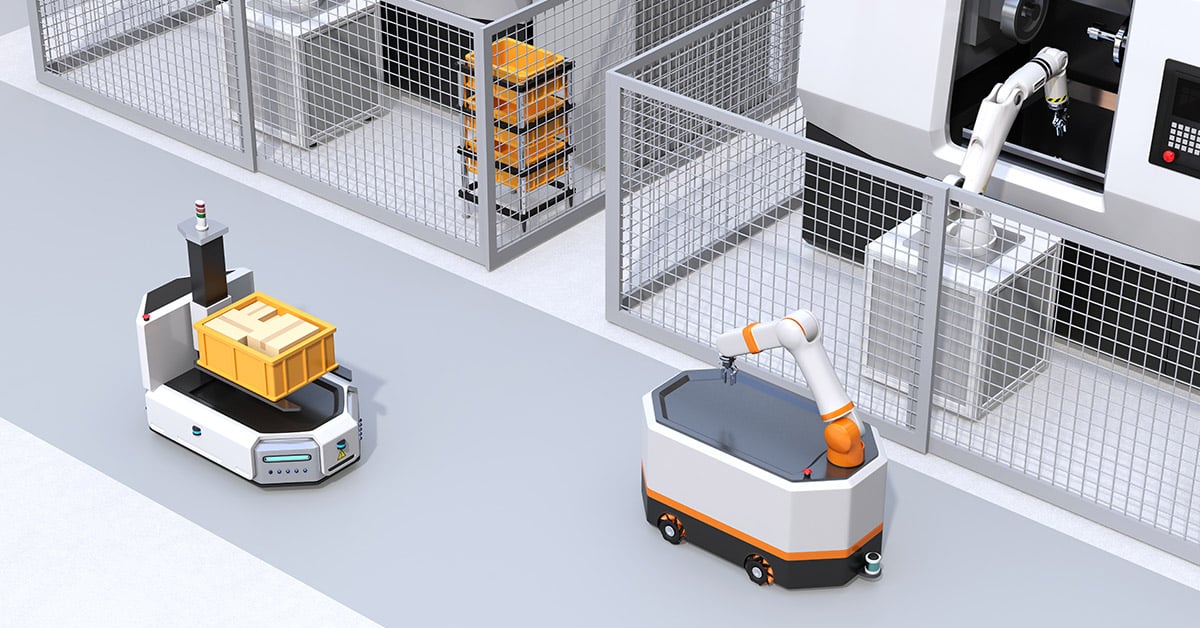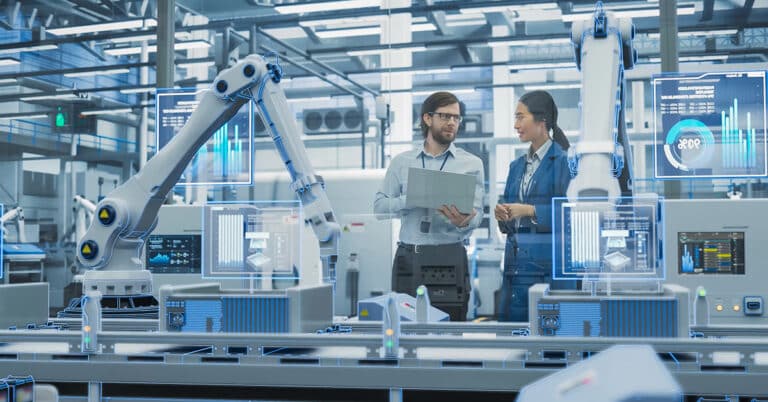The usefulness of industrial robots has always been limited by the size of their work envelope. Integrators and manufacturers have tried to address this by mounting them overhead or on rails, and while that increases their versatility, they still aren’t free to roam around the factory where they’re needed.
That paradigm changed when autonomous mobile robots (AMRs) emerged. These machines may take many forms, but their fundamental purpose remains consistent: to navigate industrial environments autonomously while fulfilling their designated functions. This blog explores the benefits manufacturers are seeing from putting AMRs to work as an additional preventive maintenance services tool in the factory.
What are autonomous mobile robots?
A robot is a machine that moves in response to instructions in a program. Many industrial robots are of the 6-axis articulated arm type that are mounted in place to do a particular type of job. Examples of the work these can do include palletizing, machine tending and pick-and-place activities.
An AMR also operates in response to programmed instructions. The big difference is that it’s not fixed to the factory floor. Instead, most have wheels and motors to drive themselves where the program tells them to go. In addition, sensors such as cameras and LiDAR help them navigate through what can be crowded and unpredictable environments.
The AMR is an evolution of the automated guided vehicle (AGV). These emerged during the 1970s and ’80s to move material through factories and warehouses without a human operator. AGVs however needed complex guidance systems (many followed a wire buried in the floor) and were unable to deviate from the planned path. In contrast, an AMR picks its own path to get to wherever it’s sent.
Though first used in warehousing, where they replaced AGVs, AMRs in manufacturing are increasing. The initial applications were material handling and parts delivery, but today there’s growing recognition of the value of AMRs in maintenance.
This arises from using the AMR as what’s been called a “dynamic sensing platform.” Equipped with an array of sensors, an AMR can visit remote and/or inaccessible locations and return data on the conditions there. This can be reviewed manually or as part of a predictive maintenance system to determine maintenance needs and initiate work as required.
As many AMRs are wheeled, naturally there are challenges when encountering stairs or steps. This issue can be addressed using a quadruped machine designed to navigate more complex environments. For example, one such robot – comparable in size and weight to a medium-sized dog and equipped with various sensors – has been utilized by a pet food manufacturer for preventive maintenance tasks, such as detecting compressed air leaks and monitoring equipment for overheating. These new ergonomic and safety advantages are having an impact all across industrial settings.
Benefits of AMRs in maintenance
Using an AMR in preventive maintenance confers a host of benefits. These are:
- Improved efficiency: Automating routine monitoring tasks frees-up maintenance personnel for more complex problem-solving and troubleshooting work that helps them stay up to date with the preventive maintenance schedule.
- Increased accuracy: Cameras and microphones provide more accurate data than manual observations, and transferring the data almost immediately to the CMMS or other computer system avoids transcription errors.
- Scalability: Additional AMRs can be deployed as needed to support a large site or campus.
- Parts inventory management: Operating a predictive maintenance strategy and using monitoring data obtained from AMRs allows reductions in inventory as parts can be ordered when needed rather than being kept on the shelf.
- Reduced labor costs: An autonomous maintenance AMR does the routine tasks that previously required a skilled maintenance technician. By letting the technician focus on more challenging work the maintenance workload and overtime working are reduced.
- Enhanced safety: An AMR can get into places that are cramped and otherwise difficult for a human to reach. They can go where temperatures are high or low and where lighting is limited. This saves human workers from endangering themselves while trying to gather data.
- Upskilling workers to operate alongside AMRs: Handing-off low skill tasks to an AMR creates an opportunity to develop the skills of maintenance workers who no longer need do these routine jobs.
Integrating AMRs with existing systems
Autonomous maintenance AMRs should be part of the “smart factory” concept many industrial businesses are moving toward. This is where shop floor automation such as individual machines, manufacturing lines and robots are linked with ERP, Quality management, asset management and the CMMS in a “digital transformation.”
Key elements management should address during this transition include how AMRs will operate within the existing infrastructure, linkages to predictive maintenance systems and their relationship with the Industrial Internet of Things (IIoT).
Technical integration with plant infrastructure
Not all plants are constructed on a single level, and not all equipment can be installed at ground level. This creates challenges for conventional wheeled AMRs that can’t use stairs. In such situations, management must consider if quadruped AMRs make more sense than duplicating machines at different levels.
Synergy with IIoT and predictive maintenance systems
Autonomous maintenance AMRs are another tool for capturing data for predictive maintenance. The choice between them and IIoT devices comes down to issues such as sampling frequency, distance from where the data is sent and saved and costs.
Challenges and considerations
As manufacturers explore the potential for robotics in maintenance, the overriding concern will be ROI. This is driven by decisions relating to what data to collect and how it’s used to guide maintenance decisions.
On a technical level, the biggest challenge in most plants is achieving the required levels of connectivity. While Wi-Fi technology continues to improve, prospective AMR users should be open to cellular networks, especially on larger sites.
Partner with industrial maintenance specialists
Faced with unrelenting cost pressures, manufacturers are constantly looking for technologies that can help maximize efficiencies. This should extend to equipment maintenance as improvements here can save money, prolong asset life and increase effective capacity. ATS helps industrial businesses pursue these objectives with a portfolio of offerings including predictive maintenance services. Contact us to learn more.






